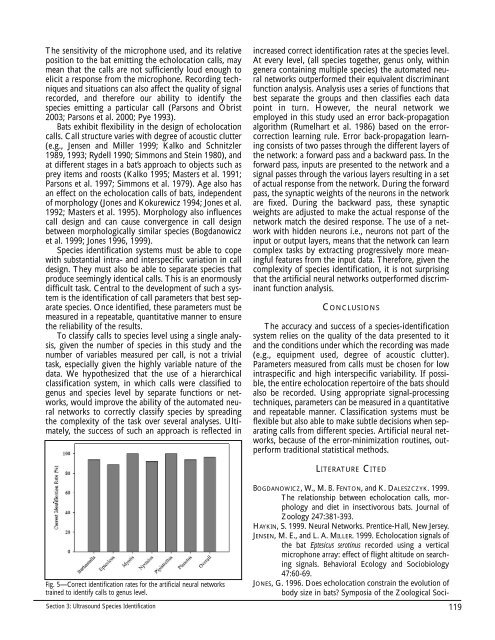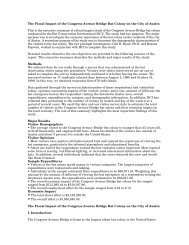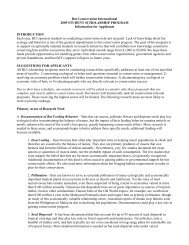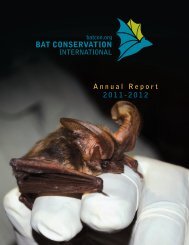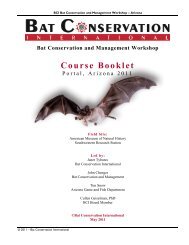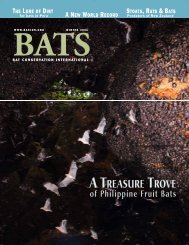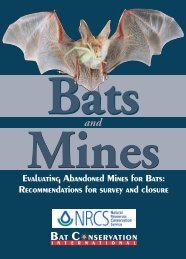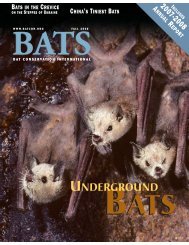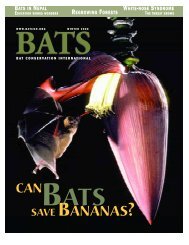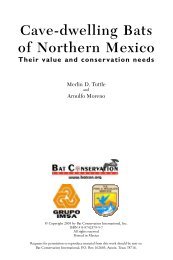Bat Echolocation Researc h - Bat Conservation International
Bat Echolocation Researc h - Bat Conservation International
Bat Echolocation Researc h - Bat Conservation International
Create successful ePaper yourself
Turn your PDF publications into a flip-book with our unique Google optimized e-Paper software.
The sensitivity of the microphone used, and its relative<br />
position to the bat emitting the echolocation calls, may<br />
mean that the calls are not sufficiently loud enough to<br />
elicit a response from the microphone. Recording techniques<br />
and situations can also affect the quality of signal<br />
recorded, and therefore our ability to identify the<br />
species emitting a particular call (Parsons and Obrist<br />
2003; Parsons et al. 2000; Pye 1993).<br />
<strong>Bat</strong>s exhibit flexibility in the design of echolocation<br />
calls. Call structure varies with degree of acoustic clutter<br />
(e.g., Jensen and Miller 1999; Kalko and Schnitzler<br />
1989, 1993; Rydell 1990; Simmons and Stein 1980), and<br />
at different stages in a bat’s approach to objects such as<br />
prey items and roosts (Kalko 1995; Masters et al. 1991;<br />
Parsons et al. 1997; Simmons et al. 1979). Age also has<br />
an effect on the echolocation calls of bats, independent<br />
of morphology (Jones and Kokurewicz 1994; Jones et al.<br />
1992; Masters et al. 1995). Morphology also influences<br />
call design and can cause convergence in call design<br />
between morphologically similar species (Bogdanowicz<br />
et al. 1999; Jones 1996, 1999).<br />
Species identification systems must be able to cope<br />
with substantial intra- and interspecific variation in call<br />
design. They must also be able to separate species that<br />
produce seemingly identical calls. This is an enormously<br />
difficult task. Central to the development of such a system<br />
is the identification of call parameters that best separate<br />
species. Once identified, these parameters must be<br />
measured in a repeatable, quantitative manner to ensure<br />
the reliability of the results.<br />
To classify calls to species level using a single analysis,<br />
given the number of species in this study and the<br />
number of variables measured per call, is not a trivial<br />
task, especially given the highly variable nature of the<br />
data. We hypothesized that the use of a hierarchical<br />
classification system, in which calls were classified to<br />
genus and species level by separate functions or networks,<br />
would improve the ability of the automated neural<br />
networks to correctly classify species by spreading<br />
the complexity of the task over several analyses. Ultimately,<br />
the success of such an approach is reflected in<br />
increased correct identification rates at the species level.<br />
At every level, (all species together, genus only, within<br />
genera containing multiple species) the automated neural<br />
networks outperformed their equivalent discriminant<br />
function analysis. Analysis uses a series of functions that<br />
best separate the groups and then classifies each data<br />
point in turn. However, the neural network we<br />
employed in this study used an error back-propagation<br />
algorithm (Rumelhart et al. 1986) based on the errorcorrection<br />
learning rule. Error back-propagation learning<br />
consists of two passes through the different layers of<br />
the network: a forward pass and a backward pass. In the<br />
forward pass, inputs are presented to the network and a<br />
signal passes through the various layers resulting in a set<br />
of actual response from the network. During the forward<br />
pass, the synaptic weights of the neurons in the network<br />
are fixed. During the backward pass, these synaptic<br />
weights are adjusted to make the actual response of the<br />
network match the desired response. The use of a network<br />
with hidden neurons i.e., neurons not part of the<br />
input or output layers, means that the network can learn<br />
complex tasks by extracting progressively more meaningful<br />
features from the input data. Therefore, given the<br />
complexity of species identification, it is not surprising<br />
that the artificial neural networks outperformed discriminant<br />
function analysis.<br />
CONCLUSIONS<br />
The accuracy and success of a species-identification<br />
system relies on the quality of the data presented to it<br />
and the conditions under which the recording was made<br />
(e.g., equipment used, degree of acoustic clutter).<br />
Parameters measured from calls must be chosen for low<br />
intraspecific and high interspecific variability. If possible,<br />
the entire echolocation repertoire of the bats should<br />
also be recorded. Using appropriate signal-processing<br />
techniques, parameters can be measured in a quantitative<br />
and repeatable manner. Classification systems must be<br />
flexible but also able to make subtle decisions when separating<br />
calls from different species. Artificial neural networks,<br />
because of the error-minimization routines, outperform<br />
traditional statistical methods.<br />
LITERATURE CITED<br />
Fig. 5—Correct identification rates for the artificial neural networks<br />
trained to identify calls to genus level.<br />
Section 3: Ultrasound Species Identification<br />
BOGDANOWICZ, W., M. B. FENTON, and K. DALESZCZYK. 1999.<br />
The relationship between echolocation calls, morphology<br />
and diet in insectivorous bats. Journal of<br />
Zoology 247:381-393.<br />
HAYKIN, S. 1999. Neural Networks. Prentice-Hall, New Jersey.<br />
JENSEN, M. E., and L. A. MILLER. 1999. <strong>Echolocation</strong> signals of<br />
the bat Eptesicus serotinus recorded using a vertical<br />
microphone array: effect of flight altitude on searching<br />
signals. Behavioral Ecology and Sociobiology<br />
47:60-69.<br />
JONES, G. 1996. Does echolocation constrain the evolution of<br />
body size in bats? Symposia of the Zoological Soci-<br />
119


